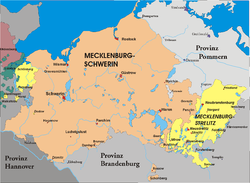Grand Duchy of Mecklenburg Friedrich-Franz Railway

The Grand Duchy of Mecklenburg Friedrich-Franz Railway (Großherzoglich Mecklenburgische Friedrich-Franz-Eisenbahn or M.F.F.E.) was the state railway company in
Context

Mecklenburg is a region in northern Germany comprising the western and larger part of the present day state of Mecklenburg-Vorpommern. Its largest cities are Rostock, Schwerin, and Neubrandenburg. In 1815, the two Mecklenburg duchies - Grand Duchy of Mecklenburg-Schwerin and Mecklenburg-Strelitz - were raised to Grand Duchies, and subsequently existed separately in Germany until the end of World War I. The earlier private railways were nationalised by 1890 into the Grand Duchy of Mecklenburg Friedrich-Franz Railway.
En Route to a state railway
First railways in Mecklenburg
The first railway route in Mecklenburg was the Prussian Berlin–Hamburg line, which opened in 1846. As a result, stations appeared in Ludwigslust and Hagenow and other places. On 10 March 1846 the Mecklenburg Railway Company was given the concession to build a route from Hagenow to Schwerin and on to Wismar, and via Bützow to Rostock with a branch to Güstrow. On 13 May 1850 the line was finished.
The Friedrich-Franz railway
Although the Mecklenburg Railway Company had completed the line, it lacked an east–west link that would also connect to the Grand Duchy of Mecklenburg-Strelitz.
Because there were no financially influential backers, the route Güstrow -
First nationalisation
The desire for state control over the construction and operation of railways led in 1873 to the nationalisation of the railways in Mecklenburg. The Mecklenburg government also wanted to preempt the purchase of the railways by the Reich railways planned by Chancellor Otto von Bismarck. The operating profits of the Mecklenburg Railway Company were another reason for the takeover.
On 20 April 1873 the state government bought the Mecklenburg Railway Company and merged it with the Friedrich-Franz Railway into the Grand Duchy of Mecklenburg Friedrich-Franz Railway. The headquarters of the company was moved from Malchin to the state capital, Schwerin.
Reprivatisation
In 1875, the Grand Duchy of Mecklenburg Friedrich-Franz Railway was reprivatised. The reason was a dispute between the former railway shareholders and the government, because the latter could not pay back the circa 10 million
Between 1875 and 1890 a multitude of new railway routes emerged, built by private railway concerns.
- The Parchim-Ludwigslust Railway constructed a line between the towns of the same name.
- The Güstrow-Plau Railway built a route from Plaaz via Güstrow as far as Meyenburg on the Prussian border.
- The Wismar-Rostock Railway put in the direct connexion between the two harbour towns.
- The Gnoien-Teterow Railway linked the town of Gnoien to the network.
- The Mecklenburg Southern Railway succeeded in building the connexion between Parchim, Lübz, Waren (Müritz), Penzlin and Neubrandenburg.
- The Lloyd Railway built a connexion from Neustrelitz via Waren to Rostock and Warnemünde.
- The Wismar-Karow Railway made a link to the railway junction at Karow, where the Southern Railway and Güstrow-Plau Railway crossed.
- Finally the construction of the narrow gauge Doberan-HeiligendammRailway was completed.
Grand Duchy of Mecklenburg Friedrich-Franz Railway

On the second nationalisation in 1889/1890 the management of the state railway was transferred to the GGED (see above). The railway was known from then on as the Grand Duchy of Mecklenburg Friedrich-Franz Railway (Großherzoglich Mecklenburgische Friedrich-Franz-Eisenbahn, M.F.F.E.)
In 1889/1890 all existing nine private railways were purchased by the state, the acquisition of the larger, more profitable companies taking a little longer.
The 'Grand Duchy of Mecklenburg Friedrich-Franz Railway built a number of new routes in order to provide better rail transport services for the country:
- Tessin|Rostock–(Bad)Sülze–Tribsees (with a connexion to the Franzburg Southern Railway and the Tribsees–Grimmen–Greifswald route (1895)
- Schwerin–Rehna (1897)
- Grevesmühlen–Klütz (1905)
- Schönberg–Dassow (1905)
- Malchin–Dargun (1907)
- Heiligendamm–Arendsee (today the Baltic Sea spa Kühlungsborn-West)(1910).
Mecklenburg railway ferries on the Baltic Sea
In 1903 the post steamer link from Warnemünde to
War, November Revolution, Deutsche Reichsbahn
The onset of the
After the
Locomotives in Mecklenburg
Mecklenburg centred its procurement of locomotives on its largest neighbour, Prussia. As far as possible, Prussian designs were used. One genuine Mecklenburg engine was the T 4, a tank locomotive for branch line operations. In contrast to other German railway administrations the M.F.F.E. ordered no express train locomotives. The transportation of international express trains from Berlin via Warnemünde and Gedser to Copenhagen and the fast trains from Rostock to Hamburg were handled by Prussian P 8s, that with a top speed of 100 km/h had sufficiently high speeds for those services.
An overview of the engines used by the M.F.F.E. is given in the List of Mecklenburg locomotives.
Memories of the M.F.F.E. today
Only a few signs of Mecklenburg' former railway are left today. In
See also
References
- Schulz, Lothar (1986). Die Eisenbahnen in Mecklenburg (in German). Berlin: transpress. ISBN 3-344-00068-3.
